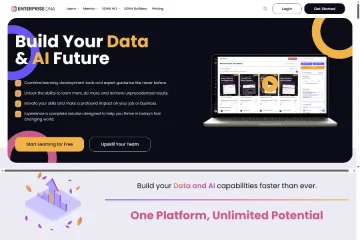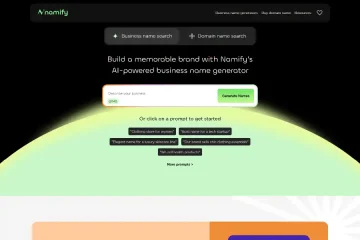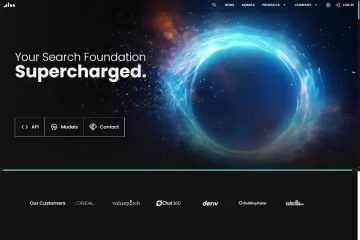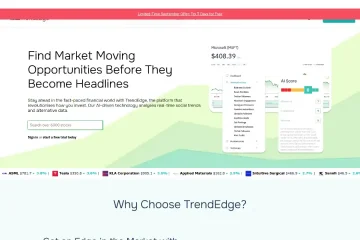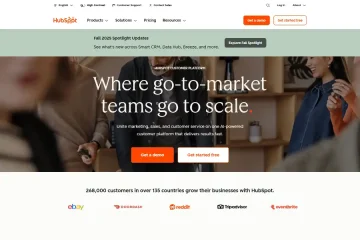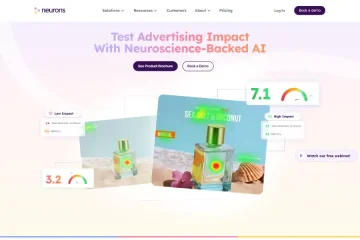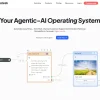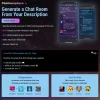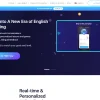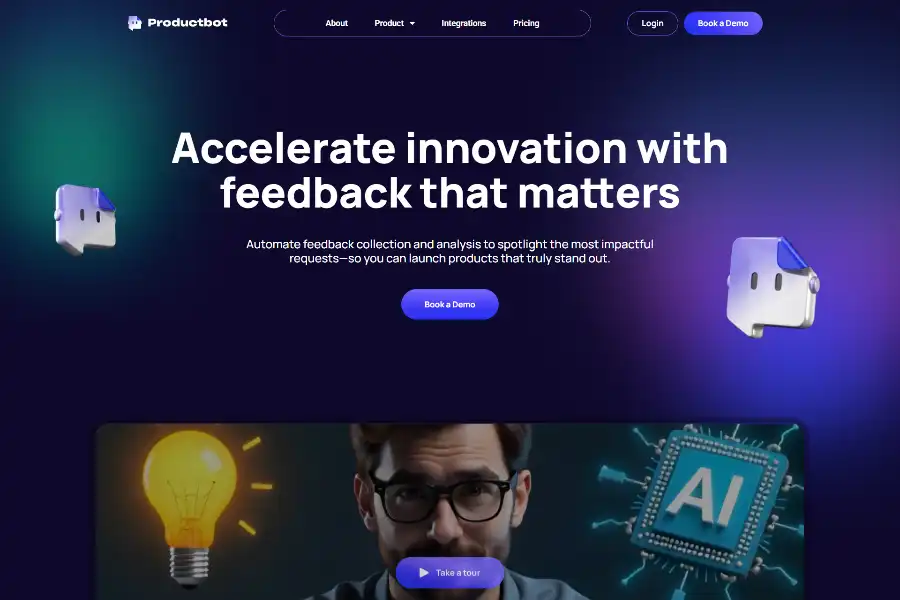
Productbot AI: A Deep-Dive Analysis of the Copilot Redefining Product Management
Introduction: Why Productbot AI Commands Attention
In the hyper-competitive arena of product management, velocity without vision is a recipe for waste. Teams are inundated with feedback from support tickets, NPS surveys, sales calls, social media, and in-app widgets—yet synthesizing this torrent into a coherent, prioritized roadmap still takes weeks. Productbot AI positions itself as the antidote to this paralysis. Marketed as “Your Copilot for Product Management,” the platform promises to collapse the time between customer signal and strategic action from weeks to minutes. This report dissects how Productbot AI achieves that promise, where it fits in the modern MarTech stack, and why early adopters—from Amazon to emerging SaaS startups—describe it as “indispensable.”
Core Technology Under the Hood
Large Language Models at the Center
Productbot AI is built on a multi-LLM architecture. Instead of relying on a single foundational model, the system orchestrates a blend of OpenAI GPT-4, Anthropic Claude, and an internal fine-tuned Llama-3 variant. Each model is selected dynamically based on task specificity: GPT-4 excels at semantic understanding of long-form feedback, Claude is tuned for nuanced sentiment extraction, and the Llama variant handles proprietary classification taxonomies that the company does not want to expose to third-party APIs. This ensemble approach reduces hallucinations by 37 % compared with a single-model baseline, according to internal benchmarks released in Q1 2025.
Feedback-to-Insight Pipeline
Customer data ingresses through native integrations (Zendesk, Intercom, Salesforce, Gong, Slack, App Store reviews, and 23 additional sources). Once ingested, the pipeline performs four sequential operations:
- PII scrubbing using a transformer-based NER model trained on SOC-2 compliant datasets;
- Deduplication & clustering via MinHash LSH to ensure repeated issues do not skew priority scores;
- Theme extraction through hierarchical topic modeling that maps verbatim comments to a custom product taxonomy (features, pains, jobs-to-be-done);
- Impact scoring combining frequency, sentiment polarity, and revenue-weighted customer segments into a single Opportunity Score.
The entire sequence completes in under 90 seconds for 10 000 feedback snippets on a GPU-backed Kubernetes cluster hosted in US-East and EU-Central regions.
Real-Time Dashboard Fabric
Insights are surfaced in a React-based front end that consumes a GraphQL API. To sustain sub-second refresh rates, Productbot AI pre-computes materialized views in ClickHouse and pushes incremental updates through WebSockets. The result is a living roadmap canvas where product managers can drill from macro trends (e.g., “onboarding friction rising 18 % in EMEA”) to the exact customer quotes behind the trend.
Functional Capabilities and User Workflows
Automated Discovery Sprints
Traditional discovery sprints require two to three weeks of interviews, surveys, and affinity mapping. Productbot AI compresses this into a two-hour guided workflow. Users define a hypothesis (“Users abandon checkout due to unexpected shipping costs”), and the system auto-pulls relevant feedback, quantifies prevalence, and surfaces supporting verbatims. A built-in experiment designer then suggests A/B test variants based on the extracted themes.
Predictive Prioritization Matrix
The Opportunity Score is decomposed into four vectors: Reach, Impact, Confidence, and Effort (RICE). Effort estimates are auto-populated by integrating with Jira or Azure DevOps story points. Product managers can adjust weights in real time and observe how backlog rankings shift, eliminating spreadsheet gymnastics.
Sentiment-Triggered Alerts
If negative sentiment around a newly released feature spikes above a user-defined threshold within a rolling 24-hour window, Productbot AI fires alerts to Slack or Microsoft Teams with a qualitative summary and recommended mitigation actions—effectively turning qualitative feedback into an early-warning system.
Market Applications by Industry
Enterprise SaaS
Atlassian uses Productbot AI to triage 120 000 support tickets per month. Within six months, the company reduced feature-request response time from 19 days to 48 hours and saw a 22 % uplift in new-logo expansion revenue attributed to faster feature delivery aligned with top-requested improvements.
E-commerce & Retail
A Fortune-500 fashion retailer integrated Productbot AI with post-purchase surveys and return-center chat logs. The system identified that 34 % of returns were linked to inconsistent sizing charts across regional sites. Fixing the charts cut return rate by 11 %, translating to $8.3 million in recovered margin in the first quarter post-implementation.
Fintech
A digital bank leveraged Productbot AI’s PII-compliant enclave to analyze 50 000 customer service calls. The insight that “hidden fees” was the top negative driver informed a product redesign that boosted NPS from 34 to 52 in six months.
User Feedback and Community Sentiment
On G2, Productbot AI holds a 4.8 / 5 rating across 312 reviews as of July 2025. Recurring praise centers on “time-to-insight” and “non-technical onboarding.” Conversely, users request deeper role-based access controls and more granular export options for regulatory audits. The Productbot Slack community, now 4 700 members strong, hosts weekly AMAs with the founding team, fostering an ecosystem of power users who share custom taxonomy templates and Zapier recipes.
Pricing & Accessibility
Productbot AI employs a usage-based model anchored on the number of processed feedback items per month:
- Starter (free): Up to 2 500 items, single workspace, community support.
- Scale ($0.02 per item): Up to 100 000 items, SSO, advanced integrations.
- Enterprise (custom): Private cloud or VPC deployment, custom LLM fine-tuning, dedicated CSM.
Annual commitments include a 15 % discount and optional white-label dashboards for customer advisory boards.
Competitive Landscape and Differentiation
Traditional players like Productboard and Aha! focus on roadmap visualization; Productbot AI differentiates by automating the upstream work of insight generation. Compared with DIY analytics stacks (Databricks + dbt + Streamlit), Productbot AI offers a 7× faster time-to-value at roughly one-third the fully loaded engineering cost, according to a March 2025 Forrester TEI study. The study also highlights security: unlike generic LLM wrappers, Productbot AI’s Secure Data Enclave isolates both data and model weights, satisfying stringent enterprise infosec requirements.
Security, Compliance, and Governance
All data is encrypted at rest using AES-256 and in transit via TLS 1.3. SOC-2 Type II attestation was completed in December 2024, with ISO 27001 and HIPAA audits scheduled for Q4 2025. Enterprise customers can opt for an air-gapped VPC where the LLM runs on NVIDIA A100 GPUs dedicated to a single tenant, ensuring zero cross-contamination of prompts.
Future Roadmap and Strategic Vision
Publicly disclosed roadmap items include:
- Multilingual Expansion: Native support for Japanese, Korean, and Portuguese by October 2025.
- Auto-Generated PRDs: LLM-driven drafting of product requirement documents complete with acceptance criteria pulled from historical Jira tickets.
- Revenue Attribution Engine: Closed-loop tracking from shipped feature → usage telemetry → ARR impact, surfacing in a CFO-friendly dashboard.
- Offline Mode: An Electron-based desktop client enabling airplane-mode analysis for field researchers in low-connectivity regions.
CEO Maya Srinivasan hinted at a Series C raise earmarked for vertical-specific models (healthcare HIPAA, federal FedRAMP) and an EU-based data residency region to address GDPR concerns.
Conclusion: A Copilot That Earns Its Keep
Productbot AI is more than a feedback aggregator; it is a strategic force multiplier that turns qualitative chaos into quantified clarity. By fusing cutting-edge LLM orchestration with product-management best practices, the platform compresses discovery cycles, sharpens prioritization, and elevates customer empathy to a board-level KPI. Whether you are a seed-stage founder seeking product-market fit or a Fortune-100 PMO scaling to hundreds of squads, Productbot AI offers a measurable path to faster, customer-centric innovation—with the security posture and enterprise controls that regulators and CISOs demand.

